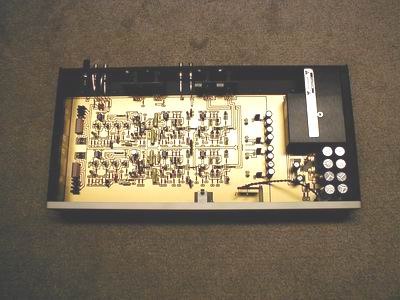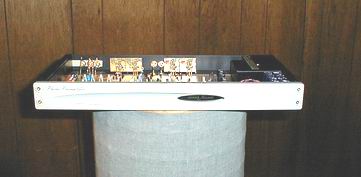InnerSound Phono Preamplifier
| InnerSound Phono Preamplifier |
|
Frank Alles |
|
12 December 2001 |
|
Frequency Response: 0.2dB of RIAA with subsonic roll-off @ 14 Hz Manufacturer NEAT, SWEET, & SLEEK! Being an analog lover at heart, I am always delighted to have the opportunity to review a promising new phono stage. In my view, a properly set up vinyl playback system can provide a type of liquid and relaxed sonic presentation that is yet to be equaled by the best digital gear. It cannot be denied that a high-quality phono preamplifier is an essential part of a high-end vinyl playback system. To those contemplating the sojourn into the world of vinyl playback, I would add that there seems to be a very good supply of used vinyl LPs; which, save for collector’s items, can often be bought for rock bottom prices. A very nice compilation of vinyl can usually be put together for a relatively small investment and a little luck in seeking out bargains and used LP outlets. Of course new vinyl is still being offered from such sources as Classic Records and Acoustic Sounds, for those who prefer to buy virgin vinyl. The InnerSound Phono Preamp (IPP) is a slim-line design with contemporary styling that is available in the buyer’s choice of a machined black or silver faceplate, with the familiar blue, recessed, back lit InnerSound logo that matches the look of the firm’s other electronic components. Its elegant and unobtrusive profile should allow for easy and inconspicuous installation in most systems. Everything from the enclosed and shielded power supply to the heavy-duty, gold-plated circuit board, to the completely machined and anodized aluminum chassis underscores the fact that this is a serious high-quality design. The circuit topology employs ultra-quiet JFET operation and is claimed by the manufacturer to be a “virtually perfect transconductance device with extremely high input impedance like tubes (10 mega-ohms) but low output impedance (50 ohms). Therefore, it is immune to the reactive nature of phono cartridges and has no impedance mismatch problems.” The IPP provides both single-ended and balanced inputs and outputs and has two gain settings to accommodate both moving coil and moving magnet cartridges. In addition to five different impedance-loading options, the IPP offers four selectable capacitance settings as well as the option of adding no extra capacitance. The loading and gain options are accessed by removing the unit’s cover and employing various combinations of the IPP’s internal DIP switches. This is not very convenient, but once the optimal values are found and set for a given cartridge there would be little reason to alter the settings. Like many solid-state phono stages, the IPP has no power on/off switch, and since it draws little power, is meant to be powered up continuously. A female IEC connector on the rear panel allows the use of after-market power cords. By using different combinations of the resistive and capacitive loading options, the focus and high frequency profile of any given cartridge can be altered (to a degree) to the listener’s preference. Not all phono preamps provide capacitive loading options, so I see its inclusion as a plus for this particular product. Playing with the different capacitive values proved interesting. By adding more capacitance you can cause a slight roll-off of the high frequencies while affecting an apparent increase in lower treble energy, which can actually make the cartridge sound brighter. InnerSound’s Roger Sanders explained that increasing the capacitance lowers the internal resonant frequency of the cartridge, which can shift the area of audible accentuation to a lower point in the treble band. For the purpose of this evaluation, I used the high gain (MC) setting, with 100 ohms impedance and the minimum capacitance setting of 50 pF. My reference American Hybrid Technology (AHT) dual-mono phono stage was also set to 100 ohms, with low capacitance to make the comparison as fair as possible. My turntable is a Michell Gyro SE II, with the new DC motor, the arm is the Rega RB250 with full Origin Live mods, and the cartridge a Benz Micro Ruby 2 low output moving coil. The IPP performed flawlessly during the time I used it. There was no mechanical hum that I could detect, and the electronic noise level was very low, though slightly higher than that of my reference phono stage through the single-ended outputs. Listening impressions
The imaging capability of the IPP is quite respectable; it throws a deep and wide stage that seems on par with that of my reference on most material. On a few recordings I thought the AHT had a little greater stage width, but the IPP was always in the ballpark. Listening to Grace Jones’ Slave to the Rhythm album [Manhattan Island ST 53021], I was surprised at how fast and coherent sounding this recording was rendered. The electronically created bells, crickets, finger snaps, and birdies sounded very clean and convincing, yet the resolving power of the IPP assured me that these high frequency percussive sounds were synthetic rather than natural. Moving to a recording with more natural instrumentation, Johnny Cash’s American Recordings [American 9-45520-1], I was pleased to find that both Johnny’s rich resonant voice and his strumming on acoustic guitar were rendered as authentically as I have ever heard them. Hearing Cash belt out “Down There By The Train” was an edifying experience, to be sure. (I love that recording!) My time evaluating the IPP was quite enjoyable. If I had to use only one word to characterize the performance of this phono stage, that word would have to be polite. The IPP is a very smooth-sounding unit-one that will almost never offend one’s sensibilities. I must tell you that its reproduction of small ensembles, jazz, and chamber music is first rate, and quite pleasing. Systems that tend to sound a bit ragged or harsh might be well served by the inclusion of the IPP; and that would include systems that use solid-state or tube phono preamps. On the other hand, as nice as the IPP sounds, it does not provide the same sense of slam and control in the lower octaves as my reference phono stage. Playing “Danse Macabre” on the Classic Records’ reissue of Witches Brew [Classic/RCA LSC-2225], which is a complex and difficult recording for any phono stage to deliver convincingly, served to highlight the few weaknesses the IPP possesses. The rumble from the subway below King’s Hall was somewhat anemic in comparison to the AHT’s rendition, and the explosive dynamic outbursts from the brass and string sections did not come across as being as poignant or incisive as they could have been. When the orchestra was blaring at full-tilt, the instrumental lines smeared together more through the IPP than through the AHT, which manifested itself by reductions in clarity and cohesiveness, reducing the impact and drama of the powerful movements somewhat. I also noticed that on recordings such as the Honey Drippers’ “I Got A Woman” [Es Paranza 7 90220-1-B], that my reference unit tended to preserve instrumental and vocal outlines to a greater degree than the IPP, which was probably attributable to its highly regulated, heavy-duty, dual-mono design. Both the backing vocals and the sax near the end of the cut sounded somehow more solid and palpable through my AHT than they did through the IPP. Comparison/Rationalization The list price of my now-discontinued AHT phono stage was 40% higher than the IPP’s price tag, and that should be taken into account here. That said, in the few areas where I felt the AHT performed better, I have not heard a phono stage with a list price of less than $3,000 USD fare any better. There are many considerably more expensive phono preamps that fall a bit short in the aforementioned areas, as well. An interesting consideration is how the performance of the IPP compares to some lower-priced overachieving units like the Lehmann Audio Black Cube and the Blue Circle BC-23 (I mention these units because I’ve reviewed them both previously for another publication). If memory and my previous notes serve, the performance of the Black Cube was close to that of the IPP; however, the IPP is slightly more refined in the treble spectrum and provides smoother, more harmonically pleasing midrange performance than the Cube. The Blue Circle BC-23 sounded closer to the IPP in the midrange (more fleshed out), but was not as refined in the high frequencies, especially in the lower treble range. Other points to ponder are that the IPP offers balanced inputs and outputs in addition to single ended connections, and that it includes capacitive loading options, which is the exception, not the norm. Plus, I think most folks would agree that the IPP, with its modern sleek slim-line styling, is just plain more SEXY than either the Cube or the BC-23, from a purely visual perspective. Conclusion In my judgement, the InnerSound phono preamp represents good value in its sonic performance, features, and in its simple elegant look. Its polite, well-balanced character should blend well in most systems, and will provide wonderful sonic results with most types of music. However, those who value ultimate bass articulation, hair-raising dynamic capability, and the ability to provide palpable instrumental outlines during complex passages may need to look a bit further (and expect to spend more money). Unlike most of its competition it had virtually no annoying, aurally offensive traits, and the fit, finish, and use of high-quality components throughout the unit is obvious. The InnerSound phono preamp provided notably smooth midrange performance and some of the airiest and most natural high frequency reproduction that I’ve had the pleasure to hear, period. Most competing products cannot measure up to the IPP’s level of treble purity. My recommendation is to put this unit on your short list and prepare yourself for a pleasant surprise.
|
Stereo Times Masthead
Publisher/Founder
Clement Perry
Editor
Dave Thomas
Senior Editors
Frank Alles, Mike Girardi, Russell Lichter, Terry London, Moreno Mitchell, Paul Szabady, Bill Wells, Mike Wright, and Stephen Yan,
Current Contributors
David Abramson, Tim Barrall, Dave Allison, Ron Cook, Lewis Dardick, John Hoffman, Dan Secula, Don Shaulis, Greg Simmons, Eric Teh, Greg Voth, Richard Willie, Ed Van Winkle, Rob Dockery, Richard Doron, and Daveed Turek
Site Management Clement Perry
Ad Designer: Martin Perry


 Specifications
Specifications Upon the transplantation of the IPP into my audio system, I was immediately pleased to find that the high-frequency reproduction appeared to be as smooth, extended, and detailed as that of my reference phono stage. The overall frequency spectrum was well balanced, with minor deviations from that of my reference unit. One difference appeared to be a very slight dip in the lower treble region that had the effect of slightly reducing record surface noise and the apparent level of tape hiss on recordings where tape hiss is noticeable. As you might suspect, this was not entirely a negative, although it may be partially responsible for the non-aggressive demeanor of the IPP.
Upon the transplantation of the IPP into my audio system, I was immediately pleased to find that the high-frequency reproduction appeared to be as smooth, extended, and detailed as that of my reference phono stage. The overall frequency spectrum was well balanced, with minor deviations from that of my reference unit. One difference appeared to be a very slight dip in the lower treble region that had the effect of slightly reducing record surface noise and the apparent level of tape hiss on recordings where tape hiss is noticeable. As you might suspect, this was not entirely a negative, although it may be partially responsible for the non-aggressive demeanor of the IPP.


Be the first to comment on: InnerSound Phono Preamplifier